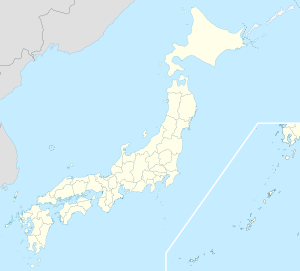Horonobe
| Horonobe-chō 幌 延 町 |
||
|---|---|---|
|
|
||
| Geographical location in Japan | ||
| Region : | Hokkaidō | |
| Prefecture : | Hokkaidō | |
| Coordinates : | 45 ° 1 ' N , 141 ° 51' E | |
| Basic data | ||
| Surface: | 574.27 km² | |
| Residents : | 2300 (September 30, 2019) |
|
| Population density : | 4 inhabitants per km² | |
| Community key : | 01488-5 | |
| Symbols | ||
| Flag / coat of arms: | ||
| Tree : | Picea glehnii | |
| Flower : | Primula takedana | |
| town hall | ||
| Address : |
Horonobe Town Hall 1 - 1 , Miyazono-chō Horonobe -chō, Teshio-gun Hokkaidō 098-3207 |
|
| Website URL: | www.town.horonobe.hokkaido.jp | |
| Location Horonobes in Hokkaidō Prefecture | ||
Horonobe ( Japanese 幌 延 町 , - chō ) is a small town in Teshio County in the Sōya sub-prefecture on Hokkaidō .
etymology
The name Horonobe comes from the Ainu , either from poro-nutap 'large land ledge (in the sense of river bend)' or poro-nup 'large plain'.
geography
On the city boundary with Nakatombetsu is the mountain Shirikoma-dake ( 知 駒 岳 ). A transmitting antenna for radio, analog and digital television is installed on this. In the west, the urban area is bounded by the Sea of Japan .
The rivers Teshio ( 天 T 川 , -gawa ), Sarobetsu ( サ ロ ベ ツ 川 , -gawa ), Onoppunai ( 雄 信 内 川 , -gawa ) and Toikambetsu ( 問 寒 別 川 , -gawa ) flow through Horonobe . At the lower reaches of the Sarobetsu is the Kami-Sarobetsu grass plain ( 上 サ ロ ベ ツ 原野 , kami Sarobetsu gen'ya ) which belongs to the Rishiri-Rebun-Sarobetsu National Park . Within this level are the lakes Panke-numa ( パ ン ケ 沼 ), Penke-numa ( ペ ン ケ 沼 ) and Naganuma ( 長 Innerhalb) in the urban area .
history
The origin of Horonobe lies in a settlement of 15 households from Fukui in 1899 on the lower reaches of the Sarobetsu. The agricultural goods named Hongan-ji , Teshio and Hokke-shū were created. In 1903 the division of the village of Teshio into two districts takes place . The area was then part of the Rumoi sub-prefecture . In 1907 339 households with 934 people from Aichi settled on the Toikambetsu river plain . On April 1, 1909, Horonobe was excluded from Teshio as a village community ( 幌 延 村 , - mura ). In 1910 the Buddhist temple Chōō-ji ( 長 応 寺 ) moved from Tokyo to Horonobe. On April 1, 1919, Horonobe merges with Saru ( 沙 流 村 , -mura ) and is promoted to 2nd class community. In the first census in 1920, 988 households with 5,349 people were counted for Horonobe. In 1935 a railway line was opened between Horonobe and Toikambetsu. On September 1, 1940, the former Saru was reunited and given the name Toyotomi . The population drops to 826 households with 4,852 people. On September 1, 1960, he was appointed Chō. At this point, Horonobe had 1,502 households with 7,432 people.
On April 1, 2010, the community was assigned to the sub-prefecture of Soya.
Attractions
Sights are the Rishiri Rebun Sarobetsu National Park. In the city is the Buddhist temple Chōō-ji from the 15th century which was dismantled in Tokyo and rebuilt here. Another tourist attraction is a reindeer holiday ranch.
traffic
Horonobe is connected to National Road 40 to Asahikawa and Wakkanai and National Road 232 to Teshio and Rumoi . Prefecture streets that cross the town limits are prefecture streets 84, 106, 121, 256, 302, 395, 541, 583, 645, 785 and 972.
Horonobe has access to the rail network through the Sōya main line from JR Hokkaido to Asahikawa and Wakkanai with the train stations Toikambetsu ( 問 寒 別 駅 , -eki ), Nukanan ( 糠 南 駅 , -eki ), Kami-Onoppunai ( 上 雄 信 内 駅 , -eki ; closed on July 1, 2001), Onoppunai ( 雄 信 内 駅 , -eki ), Yasuushi ( 安 牛 駅 , -eki ), Minami-Horonobe ( 南 幌 延 駅 , -eki ), Horonobe ( 幌 延 駅 , -eki ) , Minami-Shimonuma ( 南下 沼 駅 , -eki ; closed on March 18, 2006) and Shimonuma ( 下 沼 駅 , -eki ).
Horonobe station was the end point of the Haboro line of the state JNR to Rumoi, which was completely closed in 1987 . The Haboro line was originally used to transport coal.
economy
Horonobe's main economic activity is dairy farming with 11,000 cows within the municipality. In addition, Horobobe is a plant of the dairy company Yukijirushi Nyūgyō .
education
Teshio is home to the Horonobe Elementary School, the Horonobe Middle School and the Toikambetsu Elementary and Middle School.
Neighboring cities and communities
- Rumoi sub-prefecture:
- Soya Sub-Prefecture :
- Kamikawa Sub-Prefecture :
Web links
Individual evidence
- ↑ 北海道 環境 生活 部 ア イ ヌ 政策 推進 室 (Ed.): ア イ ヌ 語 地名 リ ス ト ホ ロ ナ ~ モ オ . S. 122 ( pref.hokkaido.lg.jp [PDF; accessed November 10, 2018]).
- ↑ ほ ろ の べ 物語 . City of Horonobe, archived from the original on September 27, 2007 ; Retrieved August 14, 2016 (Japanese).
- ↑ I 概況 . (No longer available online.) Rumoi Sub-Prefecture, p. 4 , archived from the original on August 13, 2016 ; Retrieved August 14, 2016 (Japanese). Info: The archive link was inserted automatically and has not yet been checked. Please check the original and archive link according to the instructions and then remove this notice.



